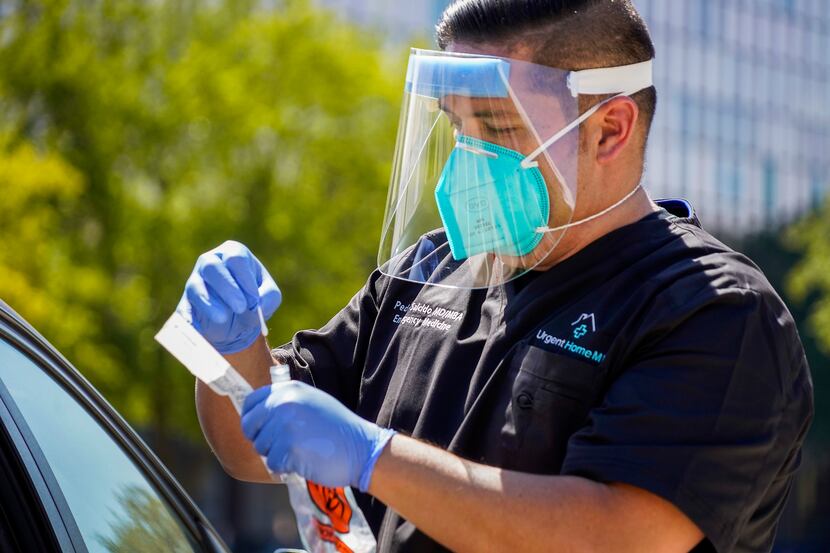As the coronavirus pandemic wears on, health officials continue to try to work out the best way to report daily coronavirus totals.
Part of the process has involved system upgrade to make tracking more efficient.
At the state level, the upgrades revealed large backlogs in COVID-19 cases — a problem that was compounded by delays caused by lab coding problems. All those setbacks created confusion about how the state and and local health departments are tracking infections.
Here’s what you need to know about how the coronavirus trends are being calculated.
Disease reporting before the pandemic
Texas law requires health-care providers, labs, hospitals and other facilities to report some diseases and illnesses to the state.
With a few exceptions, those “notifiable,” or reportable, conditions are sent to local health departments, which relay the information to the Texas Department of State Health Services, said Lara Anton, a press officer with the department.
Notifiable conditions include HIV and AIDs, cancer, influenza, chicken pox, tuberculosis, measles, mumps and some sexually transmitted diseases. Outbreaks of illnesses and exotic diseases also must be reported.
Health-care providers are required to include the patients' names, demographic details, addresses and contact information, as well as the names and contact information of their health-care providers and the way the illnesses were diagnosed.
The information is exempt from the federal Health Insurance Portability and Accountability Act, which prevents health-care providers, health plans and health-care clearinghouses from sharing patients' health information without their knowledge.
Reporting COVID-19 cases
The novel coronavirus was added this year to the state’s list of notifiable conditions, but the reporting process for COVID-19 is different from other notifiable conditions because of a March 24 executive order from Gov. Greg Abbott.
The order requires facilities using COVID-19 tests approved by the federal Food and Drug Administration to report results to both state and local health departments. Facilities also must report negative results, which isn’t required for other notifiable conditions.
Although tests must be reported at the state and local level, that doesn’t always happen right away.
“Sometimes either ... [the local health department] knew about ... [cases] ahead of time because they already had the provider report it, even if the lab wasn’t able to get their files in a format that ... [the state] could upload into the system,” Anton said, “Or the reverse, where somebody did not report it to the local health department, but they were able to send it through our system.”
The state health department shares all the positive results it receives each day with local health departments to ensure all the data are tracked.
The extra step helps ensure the numbers are timely, but means the local health departments then have to work through the data to delete any duplicate cases and compile their own daily case reports.
In Dallas County, some of the duplicates are removed through a computer system, but some of the work has to be done manually, said Dr. Philip Huang, director of the county’s health department.
The county upgraded the health department’s data platform at the beginning of October, which will improve efficiency, he said.
After the local health departments remove duplicates and add any new cases from their sources, they send their case numbers back to the state. That’s the total that appears on the statewide COVID-19 dashboard.
Differences between state and local health departments
Anton said there are several reasons for differences between the state and local accounting.
“The vast majority of ... [labs] were never testing for infectious disease before,” she said. “They’re aware of the governor’s executive order to report all COVID results to the state, but a lot of them haven’t been in the loop where they know that they’re supposed to report to the local health department, too.”
The governor’s executive order does not include any information about consequences for facilities that don’t report to both health departments.
Also, coding problems can create delays in how quickly facilities can start to send their results to the state, so it may be quicker to report cases at the local level.
It often takes a lab several tries to format its data for the state system, and that can take weeks or months to resolve.
Anton said that has led to long delays in reporting some results, but Texas is working with a contractor that helps new labs avoid problems.
Nearly 1,000 labs are sending results to the state, and “they’re adding new ones every day,” she said.
Other discrepancies can be traced to rapid tests that are often not connected to a system that can easily send results to the state’s system, Anton said.
Also, facilities such as pharmacies where people who are being tested don’t have direct contact with a doctor may not have an efficient way to send results to local health departments.
“If they’re getting tested somewhere where there isn’t a direct patient relationship with a health-care provider … it’s not like it’s your doctor there that’s reporting the results to the local health department,” Anton said. “Those types of things come to the state, and the other piece where they’re supposed to report to their local department is not happening.”

